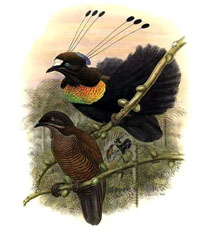Birds of paradise attract females with boomerang-shaped breast feathers

The smallest branches of the breast feathers of male birds of paradise are boomerang-shaped. This special shape enables the birds to change the colour of their breasts lightning fast, Groningen professor of biophysics Doekele Stavenga has discovered. Birds of paradise use this technique to impress females. The results of the research were published in December by the scientific journal Proceedings of the Royal Society B.
Together with Australian and British colleagues, Stavenga studied the feathers of the bird of paradise Parotia lawesii, which lives in New Guinea. The males of this species are famous for their dramatically coloured breast feathers which can suddenly change colour completely – from yellow to blue, orange or green. This seduction technique is used by the males in their mating dance.
Boomerang
The researchers discovered that the lightning fast colour changes are due to the structure of tiny barbules in the feathers – microscopically small branches off the barbs of the feather shaft. Normally in bird feathers the cross-section of these barbs is somewhat ovoid, but with birds of paradise they are curved, just like a boomerang.
Lightning fast colour changes
The boomerang shape is the secret behind the colour changes of the bird of paradise, says Stavenga: ‘The feather works rather like a triple mirror. In the middle of the boomerang shape the barbule reflects orange, and at the sides blue. By tilting the feather slightly, the spectrum changes and instead of yellow, green and purple are reflected.’
Elliptical mirror
This discovery is based on a measurement setup developed by Groningen biophysicists, an imaging scatterometer, enabling the distribution of the light that falls on an object at a single moment in time to be measured from all angles. ‘We use an elliptical mirror to do this’, says Stavenga. ‘Previously, these kinds of measurements were only made from a few angles. With this unique setup we can depict the distribution of the light across the entire 180 degrees.’
Peacocks
Other birds such as peacocks, doves and starlings also have feathers that can change colour. However, these colour changes, which depend on the angle of view, are much less abrupt than those of the bird of paradise. ‘The barbs of most bird feathers consist of layers of melanin surrounded by keratin which work like a multilayered mirror’, explains Stavenga. ‘Iridescence results in the feathers having a green or blue colour. However, the lightning-fast colour changes of the bird of paradise cannot be explained like this.’
Mating dance
The sudden colour changes of the breast feathers are part of the extraordinary mating ritual of the bird of paradise. The first step in this elaborate mating dance is to clear a ‘dance floor’. The male clears away any loose leaves or twigs from the piece of ground where he will perform his dance, simultaneously calling the females. These female birds of paradise will then watch the male performing his dance, during which he shakes his breast from side to side, causing the breast feathers to continually change colour.
Seduction technique
The boomerang-shaped barbules appear to be an evolutionary adaptation to the normal feather in order to produce dramatic colour changes, says Stavenga. ‘We humans think that it looks wonderful, but of course we have no idea how female birds of paradise actually see the colour changes. What is absolutely clear, though, is that the sudden colour changes form an important seduction technique for male birds of paradise.’
More information: Prof. Doekele G. Stavenga, tel. 050-363 4785, e-mail d.g.stavenga rug.nl
Article:
Dramatic colour changes in a bird of paradise caused by uniquely structured breast feather barbules. Authors: Doekele G. Stavenga, Hein L. Leertouwer, N. Justin Marshall and Daniel Osorio. Proceedings of the Royal Society B. 15 December 2010. (http://rspb.royalsocietypublishing.org/content/early/2010/12/11/rspb.2010.2293.full)
Source of illustration: Painting of Parotia lawesii by Richard Bowdler Sharpe (upper, male; lower, female) (http://en.wikipedia.org/wiki/File:Parotia_lawesii_by_Bowdler_Sharpe.jpg).
See also: http://www.newscientist.com/blogs/shortsharpscience/2010/12/paradise-bird-shows-off-clever.html
YouTube film: Birds of paradise: the Mating Dance (David Attenborough): http://www.youtube.com/watch?v=cEh-zclVo44
Film from the article showing the colour changes (source: Macaulay Library, Cornell University): https://macaulaylibrary.org/video/45933
More news
-
11 December 2025
Stormy planets and an unexpected atmosphere
-
09 December 2025
Faculty of Impact Grant for new brain cancer treatment
